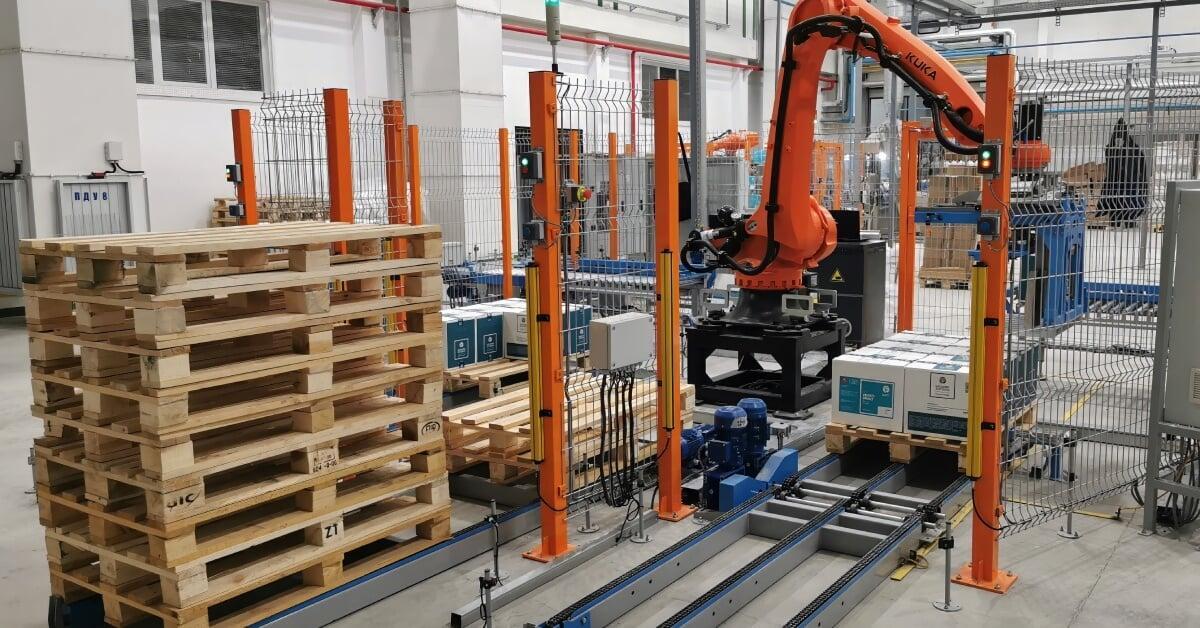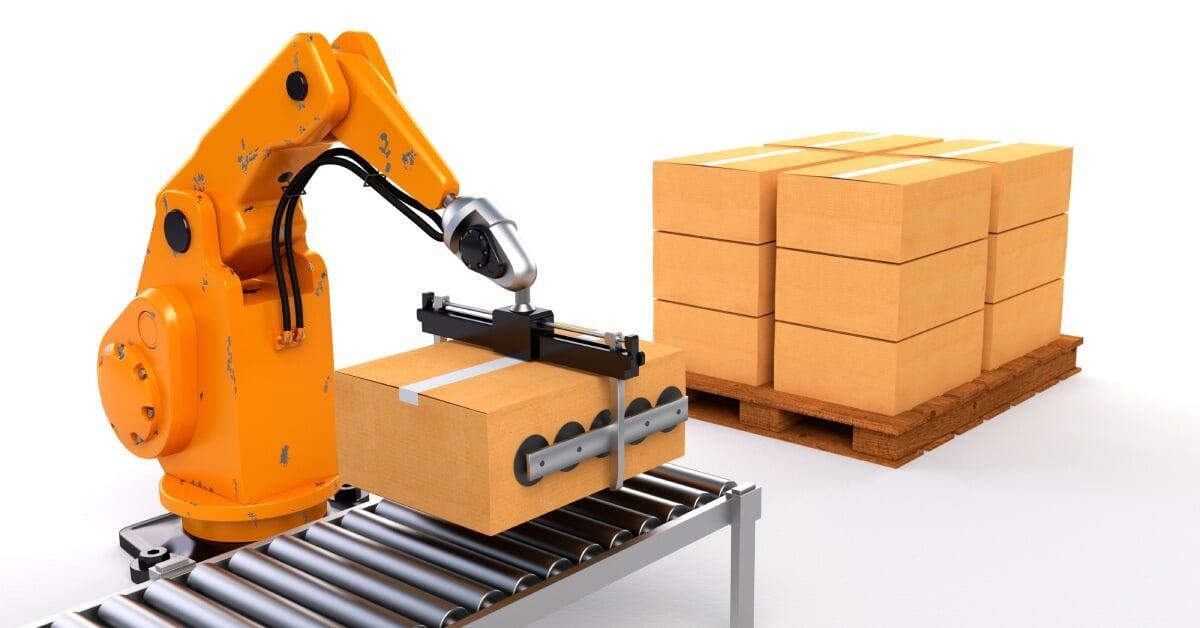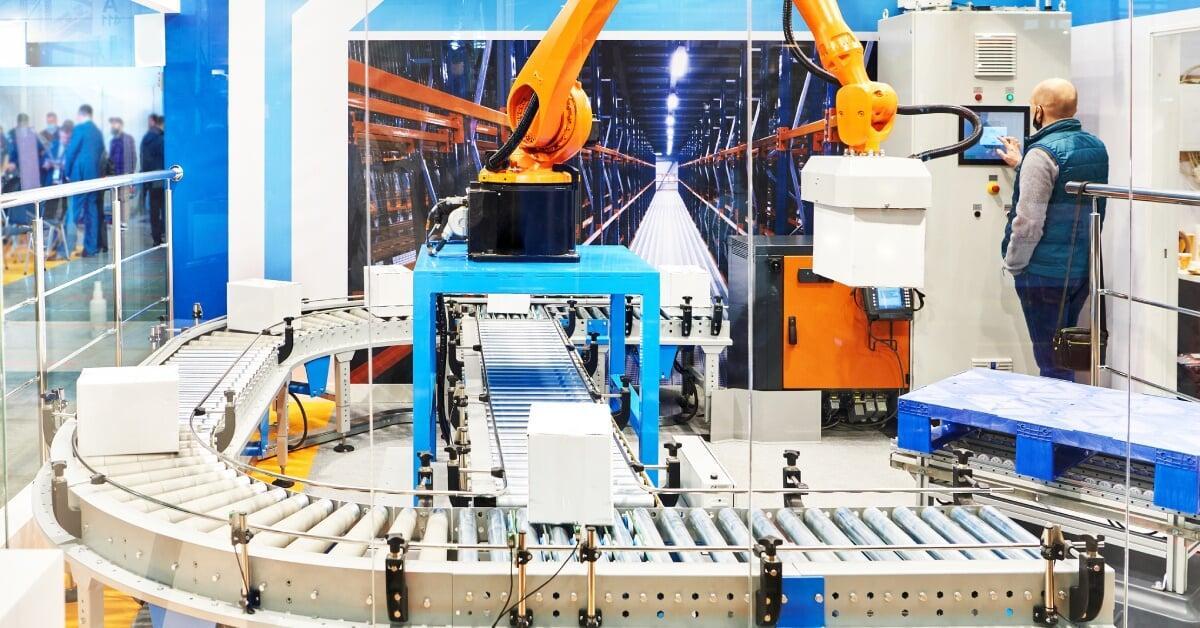
Manufacturing and distribution operations are facing mounting pressure to increase efficiency while maintaining product quality. One of the most critical decisions facility managers make is selecting the right palletizing equipment.
Palletizing machines have revolutionized how businesses handle end-of-line packaging, transforming labor-intensive processes into streamlined automated operations. Whether you’re upgrading existing equipment or implementing your first automated palletizing solution, understanding the different types of palletizing machines will help you make an informed investment decision.
What Palletizing Machines Are
Palletizing machines automate the process of arranging products onto pallets in predetermined patterns. These systems replace manual labor with mechanical precision to handle everything from bags of cement mix to boxes of consumer goods. Palletizing equipment addresses critical operational challenges including worker safety, productivity demands, and quality consistency.
Manual palletizing exposes workers to repetitive strain injuries and heavy lifting hazards. Automated systems eliminate these risks while operating continuously without fatigue. Additionally, machines maintain consistent stacking patterns that optimize pallet stability during transport and storage.
Types of Palletizing Machines
Facility managers can choose from several different types of palletizers to find the best solution for their operations.
Robotic Palletizers
Robotic palletizers represent the most flexible category of automated palletizing equipment. These systems use articulated robot arms equipped with specialized end-effectors to pick up products and place them onto pallets. The robot arm moves through programmed sequences that handle various package sizes and weights within a single operation.
The programming capabilities of robotic palletizers set them apart from other automated systems. Operators can quickly adjust stacking patterns, accommodate different product dimensions, and switch between multiple pallet configurations without mechanical modifications. This adaptability makes robotic systems particularly valuable for facilities handling diverse product lines.
Space efficiency is another notable advantage of robotic palletizers. The compact footprint allows installation in facilities with limited floor space, while the robot’s reach envelope can service multiple conveyor lines or pallet positions. Modern robotic systems can handle payloads ranging from lightweight packages to heavy industrial products exceeding 200 pounds.
In-Line Palletizers
In-line palletizers, also known as low-level palletizers, operate at ground level with products fed directly from conveyor systems. These machines use mechanical arms or pushers to position products onto pallets that remain stationary during the loading process. The straightforward design makes in-line systems relatively simple to operate and maintain.
The continuous flow design of in-line palletizers integrates seamlessly with existing production lines. Products move directly from packaging equipment onto the palletizer without elevation changes or complex transfers. This streamlined approach reduces potential jam points and maintains steady throughput rates.
In-line systems excel in applications requiring consistent, high-volume palletizing of uniform products. The mechanical simplicity translates to reliable operation with minimal downtime. However, the ground-level operation requires adequate floor space for both the machine and pallet handling equipment.

Layer-Forming Palletizers
Layer-forming palletizers take a different approach by creating complete layers of products before transferring them to pallets. These systems use a forming area to arrange products into predetermined patterns, then a layer transfer mechanism moves the entire layer onto the pallet in a single operation.
The layer-forming process allows for complex stacking patterns that would be difficult to achieve with other palletizing methods. You can orient products in multiple directions within a single layer, optimizing pallet density and stability. This capability proves especially valuable for irregularly shaped packages or products requiring a specific orientation for transport.
Speed advantages emerge when handling smaller products that you can efficiently arrange in large quantities per layer. Rather than placing individual items, the system builds complete layers simultaneously, then rapidly transfers them to pallets. This approach can significantly reduce cycle times compared to single-item placement methods.
Conventional Palletizers
Conventional palletizers, sometimes called high-level palletizers, lift products to an elevated position where palletizing occurs. These systems typically feature a vertical lift mechanism that raises products to a working platform where mechanical devices arrange them onto pallets. The system lowers the completed pallets to ground level for removal.
The elevated operation provides several operational benefits. Multiple conveyor lines feed products to the palletizing level, allowing efficient handling of high-volume operations. The height advantage also enables gravity-assisted product positioning, reducing the mechanical complexity required for precise placement.
Conventional systems often incorporate sophisticated pattern formation capabilities. You can sort, orient, and arrange products into complex stacking patterns before placement on pallets. This level of pattern control makes conventional palletizers suitable for applications requiring optimized pallet configurations for storage or shipping efficiency.
Comparing Palletizing Machine Types
Each palletizing system type offers advantages suited to different operational requirements. Robotic palletizers provide maximum flexibility but require a higher initial investment and more complex programming. The versatility justifies the cost when handling multiple product types or frequent changeovers.
In-line palletizers offer cost-effective automation for straightforward applications. The mechanical simplicity reduces maintenance requirements and operator training needs. However, the limited flexibility makes these systems best suited for dedicated product lines with minimal variation.
Layer forming palletizers excel in applications requiring complex stacking patterns or high-speed operation with smaller products. The ability to create intricate layer arrangements can improve pallet stability and optimize truck loading efficiency. The trade-off comes in increased mechanical complexity and potentially higher maintenance requirements.
Conventional palletizers provide robust performance for high-volume operations with consistent products. The proven technology offers reliable operation with well-established maintenance procedures. The elevated operation requires significant vertical space and may necessitate building modifications for installation.

Factors To Consider When Choosing a Palletizing Machine
Product characteristics significantly influence palletizing system selection. Weight, dimensions, packaging materials, and fragility all affect which technologies can handle your specific products effectively. Heavy products may require robotic systems with high payload capacity, while fragile items might benefit from the gentle handling capabilities of certain mechanical systems.
Production volume requirements must align with equipment capabilities. High-speed operations may favor layer forming systems that can rapidly build and transfer complete layers. Lower volume applications might find the flexibility of robotic systems more valuable than pure speed.
Available facility space constrains equipment options. Robotic systems offer compact solutions for space-limited facilities, while conventional palletizers require significant vertical clearance. Consider both current space availability and future expansion plans when evaluating options.
Integration requirements with existing equipment can also affect system selection. Some palletizing technologies integrate more easily with specific conveyor systems or packaging equipment. Evaluate the complexity and cost of required modifications to existing infrastructure.
Budget considerations extend beyond initial purchase price to include installation, training, and ongoing operational costs. While robotic systems may have higher upfront costs, their flexibility might provide better long-term value for operations with changing requirements.
By understanding the different types of palletizing machines, you can select equipment that delivers optimal performance for your specific application while providing a foundation for future growth. At PackSmart, we know that automated palletizer equipment presents a significant operational upgrade that can transform your end-of-line processes. Explore our safe, reliable, and affordable packing solutions today to increase your efficiency and reduce your operating costs.
